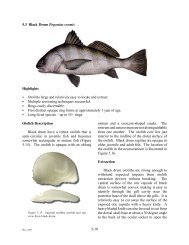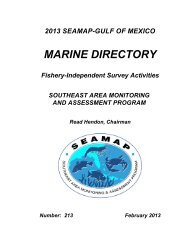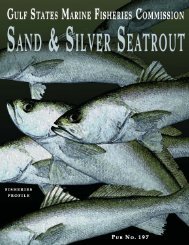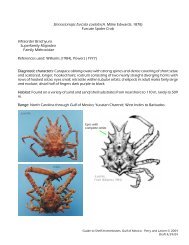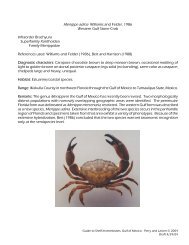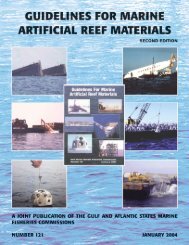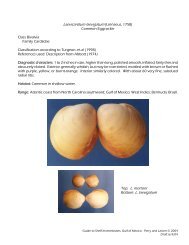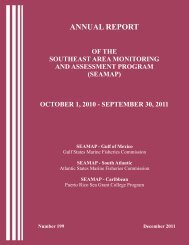Basic Commercial Fishing Regulations - Gulf States Marine ...
Basic Commercial Fishing Regulations - Gulf States Marine ...
Basic Commercial Fishing Regulations - Gulf States Marine ...
Create successful ePaper yourself
Turn your PDF publications into a flip-book with our unique Google optimized e-Paper software.
Enforcement Offices<br />
For specific information, contact<br />
your local Wildlife and Fisheries<br />
Enforcement Office.<br />
Baton Rouge 225-765-2999<br />
Minden 318-371-3049<br />
Monroe 318-343-2417<br />
Alexandria 318-487-5634<br />
Lake Charles 337-491-2580<br />
Opelousas 337-948-0257<br />
New Iberia 337-373-0032<br />
Thibodaux 985-447-0821<br />
New Orleans 504-284-2023<br />
The following digest includes a<br />
summary of assorted statutes contained<br />
in Title 56 of the Louisiana<br />
Revised Statutes as well as relevant<br />
rules and regulations adopted by the<br />
Louisiana Wildlife and Fisheries<br />
Commission and the Secretary of the<br />
Department of Wildlife and Fisheries.<br />
The Secretary of the Department of<br />
Wildlife and Fisheries is authorized to<br />
implement additional restrictions in<br />
emergency situations in order to protect<br />
fish and wildlife resources.<br />
NOTICE to OFFSHORE<br />
FISHERMEN<br />
Louisiana recreational and commercial<br />
anglers fishing offshore<br />
beyond the Louisiana boundary are in<br />
federal waters and are subject to rules<br />
and regulations that may differ from<br />
those in state waters. To ensure that<br />
you are in compliance with federal<br />
regulations, you should contact the<br />
<strong>Gulf</strong> of Mexico Fishery Management<br />
Council at 813-348-1630, toll free<br />
1-888-833-1844 (write 2203 Lois<br />
Avenue, Suite 1100, Tampa, FL 33607<br />
for informational pamphlet, e-mail:<br />
gulfcouncil@gulfcouncil.org; webpage:<br />
www.gulfcouncil.org); or the<br />
National <strong>Marine</strong> Fisheries Service at<br />
(727) 824-5305.<br />
THREATENED AND<br />
ENDANGERED SPECIES<br />
Taking or harassment of any of<br />
the following species is a violation of<br />
state and federal laws: Louisiana<br />
pearlshell mussel, inflated heelsplitter<br />
mussel, fat pocketbook mussel, pink<br />
mucket mussel, American burying<br />
beetle, sea turtles, gopher tortoise,<br />
ringed sawback turtle, dusky gopher<br />
General <strong>Fishing</strong> <strong>Regulations</strong><br />
frog, brown pelican, bald eagle, peregrine<br />
falcon, whooping crane, Eskimo<br />
curlew, piping plover, interior least<br />
tern, ivory-billed woodpecker, redcockaded<br />
woodpecker, Bachman’s<br />
warbler, whales (blue, finback, sei,<br />
sperm), West Indian manatee, Florida<br />
panther, Louisiana black bear, pallid<br />
sturgeon, <strong>Gulf</strong> sturgeon, shovelnose<br />
sturgeon.<br />
PROHIBITED SPECIES<br />
Possession of these animals is<br />
also prohibited: basking shark, white<br />
shark, bigeye sand tiger shark, sand<br />
tiger shark, whale shark, Atlantic<br />
angel shark, Caribbean sharpnose<br />
shark, smalltail shark, bignose shark,<br />
Caribbean reef shark, dusky shark,<br />
Galapagos shark, narrowtooth shark,<br />
night shark, bigeye sixgill shark, bigeye<br />
thresher shark, longfin mako,<br />
sevengill shark, sixgill shark, smalltooth<br />
sawfish, largetooth sawfish,<br />
Nassau grouper and Goliath grouper.<br />
SPECIALLY REGULATED<br />
AREAS<br />
In addition to the general statewide<br />
fishing regulations, state wildlife<br />
refuges and wildlife management<br />
areas, national refuges, and certain<br />
local areas may have special regulations<br />
or restrictions on fishing. See<br />
“<strong>Fishing</strong> <strong>Regulations</strong> on WMAs and<br />
Refuges” in this pamphlet (page 27)<br />
or contact the nearest LDWF office<br />
for WMA regulations.<br />
For complete requirements<br />
regarding the taking of fish in federal<br />
waters obtain a “Recreational <strong>Fishing</strong><br />
<strong>Regulations</strong> for <strong>Gulf</strong> of Mexico<br />
Federal Waters” pamphlet from the<br />
<strong>Gulf</strong> of Mexico Fishery Management<br />
Council (see contact info in previous<br />
section: “Notice to Offshore<br />
Fishermen”)<br />
CUSTOMER SERVICE<br />
We at Louisiana Department of<br />
Wildlife and Fisheries are interested<br />
in providing quality customer service.<br />
If you would like to voice you comments<br />
or concerns regarding the<br />
Department of Wildlife and Fisheries,<br />
please fill out a comment card when<br />
you visit one of our offices located<br />
throughout the state. You can also go<br />
to the customer service portion of<br />
LDWF’s web page at: www.wlf.louisiana.gov,<br />
click on “About LDWF,”<br />
then click on “Customer Service,”<br />
57<br />
and fill out a comment card. We<br />
would appreciate any comments you<br />
have to offer.<br />
Releasing Fish<br />
Due to the increasing number of<br />
species with size and creel limits,<br />
anglers are required to release many<br />
of the fish they catch. If handled<br />
properly, released fish have a very<br />
good chance to live, grow and provide<br />
further opportunities for<br />
Louisiana anglers. Proper handling<br />
techniques include:<br />
1. When angling, do not use a slack<br />
line. Set the hook immediately.<br />
This will reduce the chance of<br />
getting the hook deeper into the<br />
throat or gut, and increase chances<br />
of survival.<br />
2. If a fish is to be released, do not<br />
let the fish become exhausted.<br />
Retrieve it quickly.<br />
3. Do not handle the fish more than<br />
absolutely necessary and do not<br />
take it from the water if possible.<br />
Handle with a wet hand, wet<br />
towel or wet glove to minimize<br />
removal of mucus (slime). Use a<br />
landing net only when necessary.<br />
Do not let the fish flop on a<br />
dry deck or beach.<br />
4. Use one of several tools available<br />
to remove the hook from the fish<br />
if the hook is visible and not in<br />
the gills.<br />
5. Where practical, use barbless<br />
hooks or flatten down the barb<br />
with pliers to make hook removal<br />
easier.<br />
6. A circle hook, used properly<br />
decreases the chance for deep<br />
hooking compared to J-style or<br />
kahle hooks.<br />
7. If the hook is deeply buried, cut<br />
the leader close to the hook.<br />
8. Immediately put the fish back<br />
into the water. If it is sluggish,<br />
gently hold it and move it forward<br />
and back to get water moving<br />
across the gills.<br />
Even fish that seem in poor shape<br />
have a chance of survival. Treating<br />
them with care increases that chance.<br />
By conscientiously working to reduce<br />
stress on released fish, all anglers<br />
benefit.<br />
General Information<br />
7




